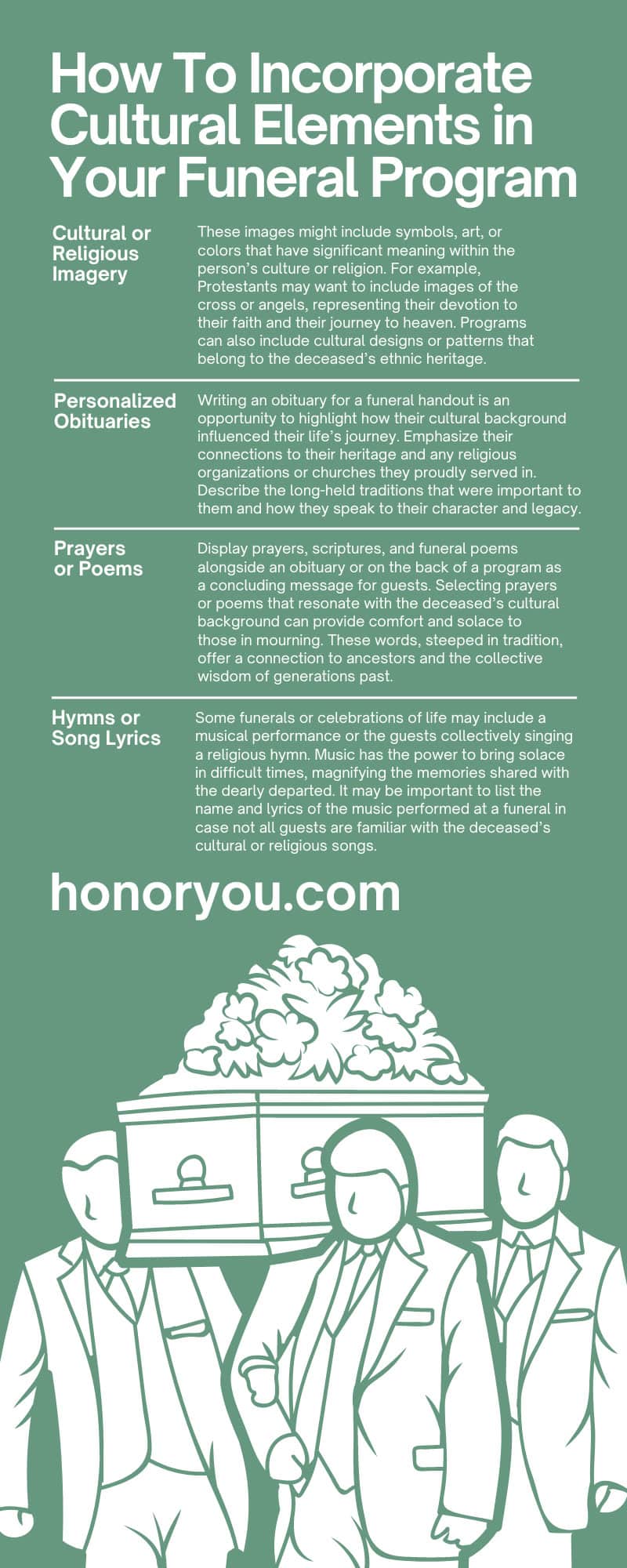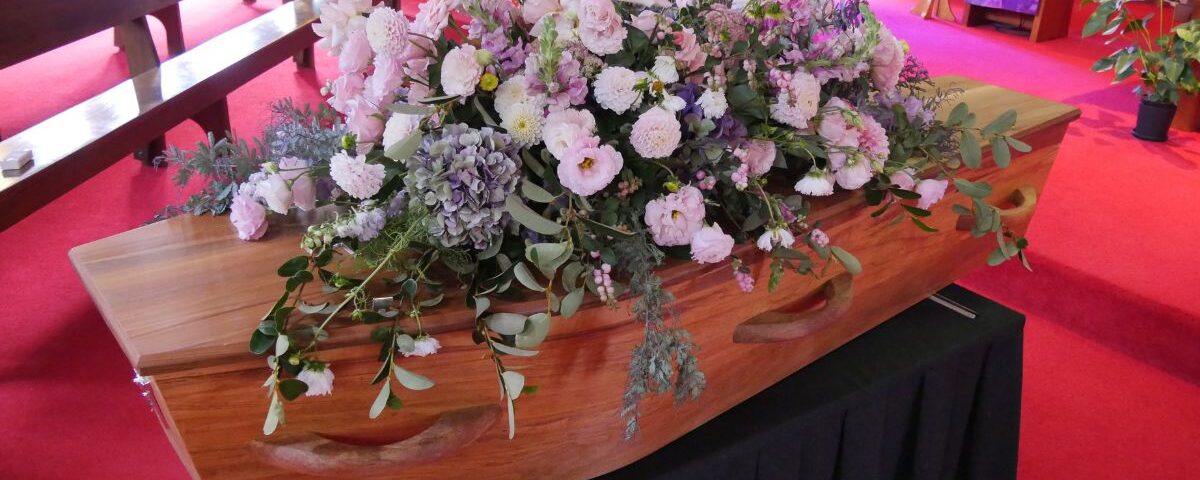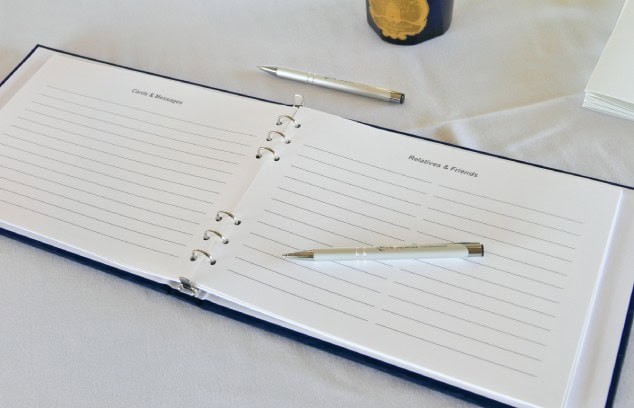How To Incorporate Cultural Elements in Your Funeral Program

The Best Ways To Display Photos at a Funeral
May 13, 2024
Preserving Funeral Register Books As Keepsakes
May 24, 2024Grieving a loved one and planning their memorial service requires a lot of logistics. The funeral ceremony should reflect the legacy and heritage the dearly departed has left behind. Many funeral traditions and arrangements honor the cultural and personal beliefs and rituals held by the deceased and their families.
Therefore, consider learning how to incorporate cultural elements into your funeral program. These programs serve as memorial keepsakes for those in mourning and honor the significance of the deceased’s heritage shared with their surviving friends and family. Continue reading to learn the importance of funeral programs and how to design one that celebrates the culture of the dearly departed.
What Is a Funeral Program?
A funeral program, or a memorial or obituary program, outlines fundamental information about the deceased and their funeral or memorial service. It serves as a guide for attendees, detailing the order of the service while commemorating the person who has passed away. Funeral handouts typically have four pages of thoughtfully selected images and text to paint a complete picture of how the dearly departed wished for their family and friends to remember them.
What Should Be on a Funeral Program?
Funeral programs are incredibly personal and tend to include certain elements that encompass details about the deceased and their service. The cover of a funeral program should display details such as the full name and dates of birth and passing, and information about the time and date of the service.
The inside of the program is where families can personalize the contents, reflecting their loved one’s legacy. Many choose to include a sentimental obituary that describes the most important moments of their loved one’s life. Opposite the obituary is the service’s schedule, along with the names of key people involved, such as the officiant.
Why Are Cultural Funeral Programs Important?
Funerals and celebrations of life should pay homage to the traditions and beliefs that were important to the deceased and their family. Designing a program with cultural elements is an effective way to celebrate the cultural bonds that unite communities and give our lives deeper meaning.
Incorporating cultural elements into a funeral program acknowledges the role that cultural identity played in the deceased loved one’s experiences and the way they viewed the world. It honors the individual’s achievements and relationships and the cultural heritage that influenced their values, dreams, and the way they lived their life.
Examples of Cultural Elements in Funeral Programs
Cultural or Religious Imagery
Incorporating imagery that reflects the deceased’s cultural or religious beliefs can create a powerful visual expression of their life and values. These images might include symbols, art, or colors that have significant meaning within the person’s culture or religion. For example, Protestants may want to include images of the cross or angels, representing their devotion to their faith and their journey to heaven. Programs can also include cultural designs or patterns that belong to the deceased’s ethnic heritage.
Personalized Obituaries
Writing an obituary for a funeral handout is an opportunity to highlight how their cultural background influenced their life’s journey. Emphasize their connections to their heritage and any religious organizations or churches they proudly served in. Describe the long-held traditions that were important to them and how they speak to their character and legacy.
Prayers or Poems
Display prayers, scriptures, and funeral poems alongside an obituary or on the back of a program as a concluding message for guests. Selecting prayers or poems that resonate with the deceased’s cultural background can provide comfort and solace to those in mourning. These words, steeped in tradition, offer a connection to ancestors and the collective wisdom of generations past.
Hymns or Song Lyrics
Some funerals or celebrations of life may include a musical performance or the guests collectively singing a religious hymn. Music has the power to bring solace in difficult times, magnifying the memories shared with the dearly departed. It may be important to list the name and lyrics of the music performed at a funeral in case not all guests are familiar with the deceased’s cultural or religious songs.
Acknowledgments From the Family
Some families may choose to add an acknowledgment, expressing their gratitude for the support they received during this difficult time. This message may be religious in nature. For example, the family will keep those mourning with them in their prayers or pray that God will also bring them peace.
Bilingual Funeral Programs
It is important to acknowledge and include family members and guests with diverse backgrounds and those who speak languages other than English. Consider listing the funeral program’s information in two languages to bridge any language barriers so that all attendees can participate fully in the service. Providing information in two languages makes the service more accessible, allowing attendees to connect with the readings, rituals, and personal anecdotes shared about the loved one.
Tips For Designing a Funeral Program
Designing a funeral program that honors cultural traditions requires sensitivity and attention to detail. The program should have a legible, elegant design appropriate for the service and the deceased’s heritage as it serves as a long-lasting memento. It is a good idea to consult the elders and community leaders who can provide valuable insights into the content and presentation style that is most appropriate for the funeral. Getting a second look at your funeral program design will better ensure it is easy to read and best honors the memory of a loved one.
Creating a funeral program infused with cultural elements is a profound way to honor a loved one’s legacy. It’s an act of love and respect that acknowledges their roots, beliefs, and the indelible mark they’ve left on the world.
Honor You specializes in crafting customized memorial keepsakes such as funeral handouts that pay homage to your loved ones’ heritage. We allow families to create custom products using templates or digital tools to design a program from scratch. Let us help you preserve your loved one’s rich heritage in a memorial handout for guests to find solace in difficult times.



